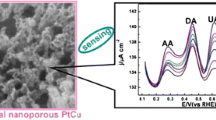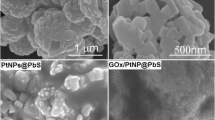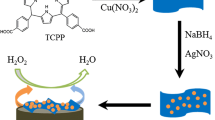Abstract
Multimodal nanoporous PtCu flowers (np-PtCu) were prepared via a two-step dealloying strategy under mild conditions. The np-PtCu alloy possesses an interconnected flower-like network skeleton with multiscale pore distribution. This material was placed on a glassy carbon electrode where it shows outstanding detection performance towards hydrogen peroxide and glucose in near-neutral pH solutions. It can be attributed to the specific structure in terms of interconnected nanoscaled ligaments, rich pore openings and a synergistic alloying effect. Figures of merit for detection H2O2 assay include (a) a working voltage of 0.7 V (vs. the reversible hydrogen electrode); (b) a wide linear response range (from 0.01 to 1.7 mM), and (c) a low detection limit (0.1 μM). The respective data for the glucose assay are (a) 0.4 V, (b) 0.01–2.0 mM, and (c) 0.1 μM. The method is not interfered in the presence of common concentrations of dopamine, acetaminophen and ascorbic acid.

Multimodal nanoporous (np) PtCu alloy was prepared via a two-step dealloying strategy under mild conditions. Np-PtCu exhibits superior electrocatalytic activity. The assay is highly sensitive, selective, and it allows for a long-term detection of H2O2 and glucose.






Similar content being viewed by others
References
Vogna D, Marotta R, Napolitano A, Andreozzi R, d’Ischia M (2004) Advanced oxidation of the pharmaceutical drug diclofenac with UV/H2O2 and ozone. Water Res 38:414–422
Opazo C, Huang X, Cherny RA (2002) Metalloenzyme-like activity of Alzheimer's disease beta-amyloid. Cu-dependent catalytic conversion of dopamine, cholesterol, and biological reducing agents to neurotoxic H2O2. J Biol Chem 277:40302–40308
Bokare AD, Choi W (2014) Review of iron-free Fenton-like systems for activating H2O2 in advanced oxidation processes. J Hazard Mater 275:121–135
Nantaphol S, Watanabe T, Nomura N, Siangproh W, Chailapakul O, Einaga Y (2017) Bimetallic Pt-Au nanocatalysts electrochemically deposited on boron-doped diamond electrodes for nonenzymatic glucose detection. Biosens Bioelectron 98:76–82
Tang Y, Liu Q, Jiang Z, Yang X, Wei M, Zhang M (2017) Nonenzymatic glucose sensor based on icosahedron AuPd@CuO core shell nanoparticles and MWCNT. Sensors Actuators B Chem 251:1096–1103
Jia L, Wei X, Lv L, Zhang X, Duan X, Xu Y, Liu K, Wang J (2018) Electrodeposition of hydroxyapatite on nickel foam and further modification with conductive polyaniline for non-enzymatic glucose sensing. Electrochim Acta 280:315–322
Hwang D, Lee S, Seo M, Chung DT (2018) Recent advances in electrochemical non-enzymatic glucose sensors-a review. Anal Chim Acta 1033(1–34):1–34
Wei P, Gan T, Wu K (2018) N-methyl-2-pyrrolidone exfoliated graphene as highly sensitive analytical platform for carbendazim. Sensors Actuators B Chem 274:551–559
Gan T, Zhao A, Wang Z, Liu P, Sun J, Liu Y (2017) An electrochemical sensor based on SiO2@TiO2-embedded molecularly imprinted polymers for selective and sensitive determination of theophylline. J Solid State Electrochem 21:3683–3691
Gan T, Lv Z, Sun Y, Shi Z, Sun J, Zhao A (2016) Highly sensitive and molecular selective electrochemical sensing of 6-benzylaminopurine with multiwall carbon nanotube@SnS2-assisted signal amplification. J Appl Electrochem 46:389–401
Bai Z, Dong W, Ren Y, Zhang C, Chen Q (2018) Preparation of nano au and Pt alloy microspheres decorated with reduced graphene oxide for nonenzymatic hydrogen peroxide sensing. Langmuir 34:2235–2244
Mei H, Wang X, Zeng T, Huang L, Wang Q, Ru D, Huang T, Tian F, Wu H, Gao J (2019) A nanocomposite consisting of gold nanobipyramids and multiwalled carbon nanotubes for amperometric nonenzymatic sensing of glucose and hydrogen peroxide. Microchim Acta 186:235–242
Gao Y, Yang F, Yu Q, Fan R, Yang M, Rao S, Lan Q, Yang Z, Yang Z (2019) Three-dimensional porous Cu@Cu2O aerogels for direct voltammetric sensing of glucose. Microchim Acta 186:192–200
Chen C, Ran R, Yang Z, Lv R, Shen W, Kang F, Huang Z (2018) An efficient flexible electrochemical glucose sensor based on carbon nanotubes/carbonized silk fabrics decorated with Pt microspheres. Sensors Actuators B Chem 256:63–70
Hu Y, Niu X, Zhao H, Tang J, Lan M (2015) Enzyme-free amperometric detection of glucose on platinum-replaced porous copper frameworks. Electrochim Acta 165:383–389
Fu Y, Huang D, Li C, Zou L, Ye B (2013) Graphene blended with SnO2 and Pd-Pt nanocages for sensitive nonenzymatic electrochemical detection of H2O2 released from living cells. Anal Chim Acta 1014:10–18
Yan X, Chen Y, Deng S, Yang Y, Huang Z, Ge C, Xu L, Sun D, Fu G, Tang Y (2017) In situ integration of ultrathin PtCu nanowires with reduced graphene oxide nanosheets for efficient electrocatalytic oxygen reduction. Chem-Eur J 23:16871–16876
Huang J, Dong Z, Li Y, Li J, Wang J, Yang H, Li S, Guo S, Jin J, Li R (2013) High performance non-enzymatic glucose biosensor based on copper nanowires-carbon nanotubes hybrid for intracellular glucose study. Sensors Actuators B Chem 182:618–624
Wang R, Liang X, Liu H, Cui L, Zhang X, Liu C (2018) Non-enzymatic electrochemical glucose sensor based on monodispersed stone-like PtNi alloy nanoparticles. Microchim Acta 185:339–345
Ye S, He X, Ding L, Pan Z, Tong Y, Wu M, Li G (2014) Cu2O template synthesis of high-performance PtCu alloy yolk-shell cube catalysts for direct methanol fuel cells. Chem Commun 50:12337–12340
Peng X, Chen D, Yang X, Wang D, Li M, Tseng CC, Panneerselvam R, Wang X, Hu W, Tian J, Zhao Y (2016) Microwave-assisted synthesis of highly dispersed PtCu nanoparticles on three-dimensional nitrogen-doped graphene networks with remarkably enhanced methanol electrooxidation. ACS Appl Mater Interfaces 8:33673–33680
Qiu H, Xu H, Li X, Wang J, Wang Y (2015) Core-shell-structured nanoporous PtCu with high Cu content and enhanced catalytic performance. J Mater Chem A 3:7939–7944
Zhou Q, Qi L, Yang H, Xu C (2018) Hierarchical nanoporous platinum-copper alloy nanoflowers as highly active catalysts for the hydrolytic dehydrogenation of ammonia borane. J Colloid Interface Sci 513:258–265
Wang J, Gao H, Sun F, Xu C (2014) Nanoporous PtAu alloy as an electrochemical sensor for glucose and hydrogen peroxide. Sensors Actuators B Chem 191:612–618
Fu S, Zhu C, Shi Q, Xia H, Du D, Lin Y (2016) Highly branched PtCu bimetallic alloy nanodendrites with superior electrocatalytic activities for oxygen reduction reactions. Nanoscale 8:5076–5081
Ghodselahi T, Vesaghi M, Shafiekhani A, Baghizadeh A, Lameii M (2008) XPS study of the Cu@Cu2O core-shell nanoparticles. Appl Surf Sci 255:2730–2734
Chen D, Zhuang X, Zhai J, Zheng Y, Lu H, Chen L (2018) Preparation of highly sensitive Pt nanoparticles-carbon quantum dots/ionic liquid functionalized graphene oxide nanocomposites and application for H2O2 detection. Sensors Actuators B Chem 255:1500–1506
Liu J, Ding S (2017) Non-enzymatic amperometric determination of cellular hydrogen peroxide using dendrimer-encapsulated Pt nanoclusters/carbon nanotubes hybrid composites modified glassy carbon electrode. Sensors Actuators B Chem 251:200–207
Doroftei F, Pinteala T, Arvinte A (2014) Enhanced stability of a Prussian blue/sol-gel composite for electrochemical determination of hydrogen peroxide. Microchim Acta 181:111–120
Heli H, Pishahang J (2014) Cobalt oxide nanoparticles anchored to multiwalled carbon nanotubes: synthesis and application for enhanced electrocatalytic reaction and highly sensitive nonenzymatic detection of hydrogen peroxide. Electrochim Acta 123:518–526
Tominaga M, Nagashima M, Nishiyama K, Taniguchi I (2007) Surface poisoning during electrocatalytic monosaccharide oxidation reactions at gold electrodes in alkaline medium. Electrochem Commun 9:1892–1898
Xie L, Asiri AM, Sun X (2017) Monolithically integrated copper phosphide nanowire: an efficient electrocatalyst for sensitive and selective nonenzymatic glucose detection. Sensors Actuators B Chem 244:11–16
Song Y, Wei C, He J, Li X, Lu X, Wang L (2015) Porous Co nanobeads/rGO nanocomposites derived from rGO/Co-metal organic frameworks for glucose sensing. Sensors Actuators B Chem 220:1056–1063
Zhong S, Zhuang J, Yang D, Tang D (2017) Eggshell membrane-templated synthesis of 3D hierarchical porous au networks for electrochemical nonenzymatic glucose sensor. Biosens Bioelectron 96:26–32
Acknowledgements
This work was supported by National Natural Science Foundation of China (51772133), Natural Science Foundation of Shandong Province (ZR2017JL022), and the program for Taishan Scholar of Shandong province (ts201712048).
Author information
Authors and Affiliations
Corresponding authors
Ethics declarations
There are no potential conflicts of interest.
Additional information
Publisher’s note
Springer Nature remains neutral with regard to jurisdictional claims in published maps and institutional affiliations.
Electronic supplementary material
ESM 1
(DOCX 422 kb)
Rights and permissions
About this article
Cite this article
Yang, H., Wang, Z., Zhou, Q. et al. Nanoporous platinum-copper flowers for non-enzymatic sensitive detection of hydrogen peroxide and glucose at near-neutral pH values. Microchim Acta 186, 631 (2019). https://doi.org/10.1007/s00604-019-3728-7
Received:
Accepted:
Published:
DOI: https://doi.org/10.1007/s00604-019-3728-7




